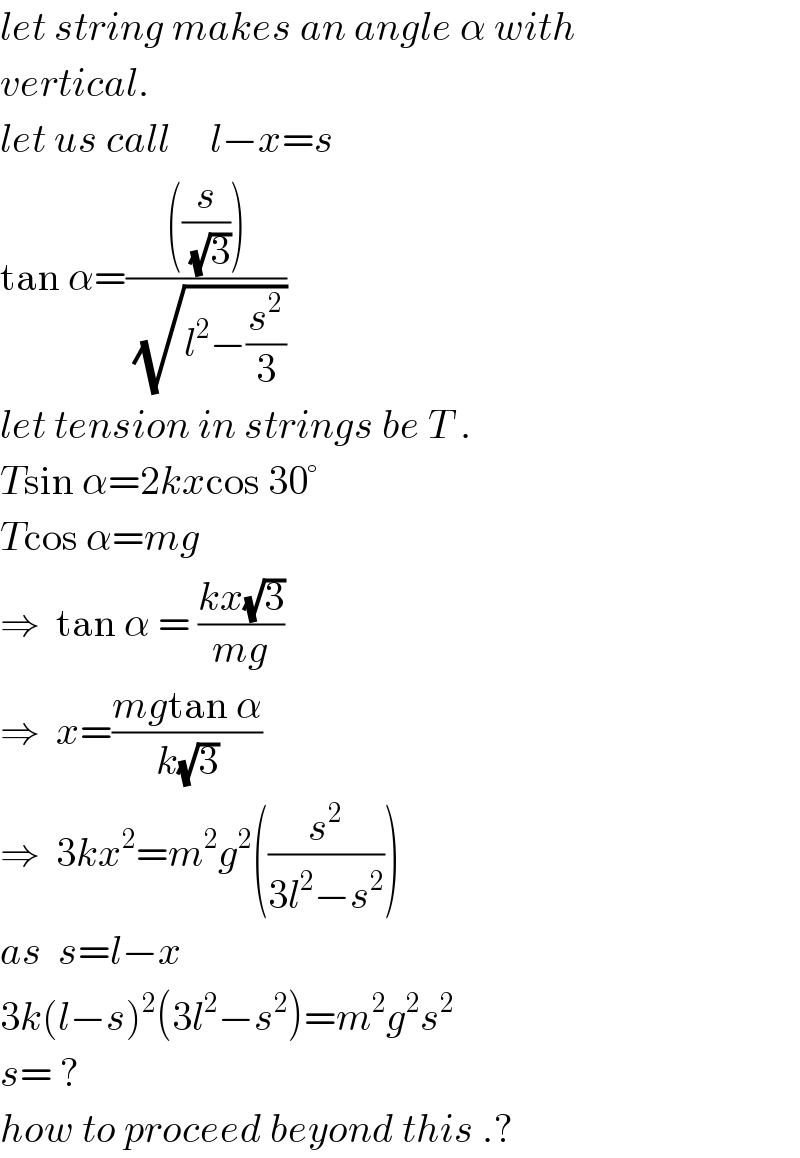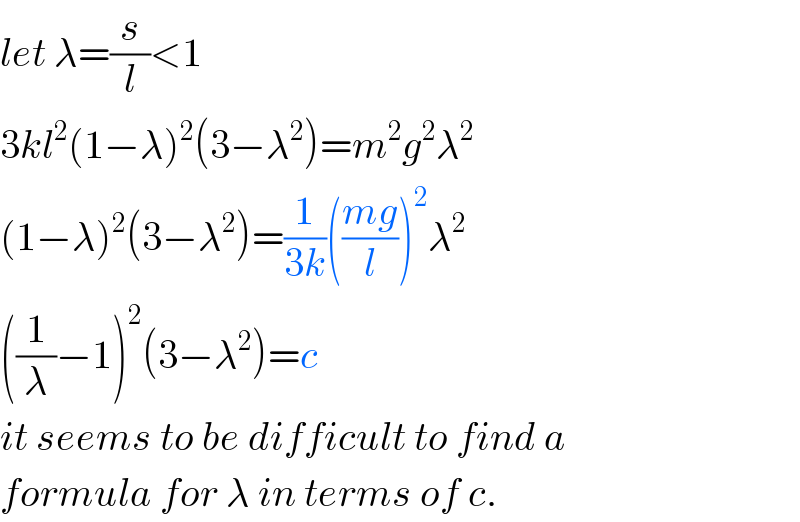
Question Number 31318 by ajfour last updated on 06/Mar/18

Commented by ajfour last updated on 06/Mar/18

$${If}\:{each}\:{spring}\:{has}\:{a}\:{natural} \\ $$$${lengh}\:\boldsymbol{{l}}\:{then}\:{find}\:{comression}\:\boldsymbol{{x}} \\ $$$${in}\:{the}\:{springs}\:{in}\:{the}\:{situation} \\ $$$${depicted}\:{in}\:{figure}\:{above}. \\ $$
Answered by ajfour last updated on 06/Mar/18

$${let}\:{string}\:{makes}\:{an}\:{angle}\:\alpha\:{with} \\ $$$${vertical}. \\ $$$${let}\:{us}\:{call}\:\:\:\:\:{l}−{x}={s} \\ $$$$\mathrm{tan}\:\alpha=\frac{\left(\frac{{s}}{\sqrt{\mathrm{3}}}\right)}{\sqrt{{l}^{\mathrm{2}} −\frac{{s}^{\mathrm{2}} }{\mathrm{3}}}} \\ $$$${let}\:{tension}\:{in}\:{strings}\:{be}\:{T}\:. \\ $$$${T}\mathrm{sin}\:\alpha=\mathrm{2}{kx}\mathrm{cos}\:\mathrm{30}° \\ $$$${T}\mathrm{cos}\:\alpha={mg} \\ $$$$\Rightarrow\:\:\mathrm{tan}\:\alpha\:=\:\frac{{kx}\sqrt{\mathrm{3}}}{{mg}} \\ $$$$\Rightarrow\:\:{x}=\frac{{mg}\mathrm{tan}\:\alpha}{{k}\sqrt{\mathrm{3}}} \\ $$$$\Rightarrow\:\:\mathrm{3}{kx}^{\mathrm{2}} ={m}^{\mathrm{2}} {g}^{\mathrm{2}} \left(\frac{{s}^{\mathrm{2}} }{\mathrm{3}{l}^{\mathrm{2}} −{s}^{\mathrm{2}} }\right) \\ $$$${as}\:\:{s}={l}−{x} \\ $$$$\mathrm{3}{k}\left({l}−{s}\right)^{\mathrm{2}} \left(\mathrm{3}{l}^{\mathrm{2}} −{s}^{\mathrm{2}} \right)={m}^{\mathrm{2}} {g}^{\mathrm{2}} {s}^{\mathrm{2}} \\ $$$${s}=\:? \\ $$$${how}\:{to}\:{proceed}\:{beyond}\:{this}\:.? \\ $$
Commented by mrW2 last updated on 07/Mar/18

$${let}\:\lambda=\frac{{s}}{{l}}<\mathrm{1} \\ $$$$\mathrm{3}{kl}^{\mathrm{2}} \left(\mathrm{1}−\lambda\right)^{\mathrm{2}} \left(\mathrm{3}−\lambda^{\mathrm{2}} \right)={m}^{\mathrm{2}} {g}^{\mathrm{2}} \lambda^{\mathrm{2}} \\ $$$$\left(\mathrm{1}−\lambda\right)^{\mathrm{2}} \left(\mathrm{3}−\lambda^{\mathrm{2}} \right)=\frac{\mathrm{1}}{\mathrm{3}{k}}\left(\frac{{mg}}{{l}}\right)^{\mathrm{2}} \lambda^{\mathrm{2}} \\ $$$$\left(\frac{\mathrm{1}}{\lambda}−\mathrm{1}\right)^{\mathrm{2}} \left(\mathrm{3}−\lambda^{\mathrm{2}} \right)={c} \\ $$$${it}\:{seems}\:{to}\:{be}\:{difficult}\:{to}\:{find}\:{a} \\ $$$${formula}\:{for}\:\lambda\:{in}\:{terms}\:{of}\:{c}. \\ $$
Commented by ajfour last updated on 07/Mar/18

$${Thanks}\:{Sir},\:{nice}\:{transformation}. \\ $$
